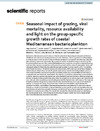Identificador persistente para citar o vincular este elemento:
https://accedacris.ulpgc.es/jspui/handle/10553/75812
| Campo DC | Valor | idioma |
|---|---|---|
| dc.contributor.author | Sánchez, Olga | en_US |
| dc.contributor.author | Ferrera, Isabel | en_US |
| dc.contributor.author | Mabrito, Isabel | en_US |
| dc.contributor.author | Gazulla, Carlota R. | en_US |
| dc.contributor.author | Sebastián, Marta | en_US |
| dc.contributor.author | Auladell, Adrià | en_US |
| dc.contributor.author | Marín-Vindas, Carolina | en_US |
| dc.contributor.author | Cardelús, Clara | en_US |
| dc.contributor.author | Sanz-Sáez, Isabel | en_US |
| dc.contributor.author | Pernice, Massimo C. | en_US |
| dc.contributor.author | Marrasé, Cèlia | en_US |
| dc.contributor.author | Sala, M. Montserrat | en_US |
| dc.contributor.author | Gasol, Josep M. | en_US |
| dc.date.accessioned | 2020-11-23T09:23:32Z | - |
| dc.date.available | 2020-11-23T09:23:32Z | - |
| dc.date.issued | 2020 | en_US |
| dc.identifier.other | Scopus | - |
| dc.identifier.uri | https://accedacris.ulpgc.es/handle/10553/75812 | - |
| dc.description.abstract | Estimation of prokaryotic growth rates is critical to understand the ecological role and contribution of different microbes to marine biogeochemical cycles. However, there is a general lack of knowledge on what factors control the growth rates of different prokaryotic groups and how these vary between sites and along seasons at a given site. We carried out several manipulation experiments during the four astronomical seasons in the coastal NW Mediterranean in order to evaluate the impact of grazing, viral mortality, resource competition and light on the growth and loss rates of prokaryotes. Gross and net growth rates of different bacterioplankton groups targeted by group-specific CARD-FISH probes and infrared microscopy (for aerobic anoxygenic phototrophs, AAP), were calculated from changes in cell abundances. Maximal group-specific growth rates were achieved when both predation pressure and nutrient limitation were experimentally minimized, while only a minimal effect of viral pressure on growth rates was observed; nevertheless, the response to predation removal was more remarkable in winter, when the bacterial community was not subjected to nutrient limitation. Although all groups showed increases in their growth rates when resource competition as well as grazers and viral pressure were reduced, Alteromonadaceae consistently presented the highest rates in all seasons. The response to light availability was generally weaker than that to the other factors, but it was variable between seasons. In summer and spring, the growth rates of AAP were stimulated by light whereas the growth of the SAR11 clade (likely containing proteorhodopsin) was enhanced by light in all seasons. Overall, our results set thresholds on bacterioplankton group-specific growth and mortality rates and contribute to estimate the seasonally changing contribution of various bacterioplankton groups to the function of microbial communities. Our results also indicate that the least abundant groups display the highest growth rates, contributing to the recycling of organic matter to a much greater extent than what their abundances alone would predict. | en_US |
| dc.language | eng | en_US |
| dc.relation | REMEI (CTM2015-70340-R), (Ministerio de Investigación e Innovación) | en_US |
| dc.relation | ANIMA (CTM2015-65720-R), (Ministerio de Investigación e Innovación) | en_US |
| dc.relation | MIAU (RTI2018-101025-B-I00), (Ministerio de Investigación e Innovación) | en_US |
| dc.relation.ispartof | Scientific Reports | en_US |
| dc.source | Scientific Reports [EISSN 2045-2322], v. 10 (1), 19773 (Diciembre 2020) | en_US |
| dc.subject | 251001 Oceanografía biológica | en_US |
| dc.title | Seasonal impact of grazing, viral mortality, resource availability and light on the group-specific growth rates of coastal Mediterranean bacterioplankton | en_US |
| dc.type | info:eu-repo/semantics/Article | en_US |
| dc.type | Article | en_US |
| dc.identifier.doi | 10.1038/s41598-020-76590-5 | en_US |
| dc.identifier.scopus | 85095953409 | - |
| dc.contributor.authorscopusid | 55313840300 | - |
| dc.contributor.authorscopusid | 6508130108 | - |
| dc.contributor.authorscopusid | 57219894166 | - |
| dc.contributor.authorscopusid | 57219892332 | - |
| dc.contributor.authorscopusid | 14031974200 | - |
| dc.contributor.authorscopusid | 57208027261 | - |
| dc.contributor.authorscopusid | 51665476800 | - |
| dc.contributor.authorscopusid | 23569413500 | - |
| dc.contributor.authorscopusid | 57207774918 | - |
| dc.contributor.authorscopusid | 56702492600 | - |
| dc.contributor.authorscopusid | 6603922904 | - |
| dc.contributor.authorscopusid | 7103244252 | - |
| dc.contributor.authorscopusid | 7003299234 | - |
| dc.identifier.eissn | 2045-2322 | - |
| dc.identifier.issue | 1 | - |
| dc.relation.volume | 10 | en_US |
| dc.investigacion | Ciencias | en_US |
| dc.type2 | Artículo | en_US |
| dc.description.numberofpages | 15 | en_US |
| dc.utils.revision | Sí | en_US |
| dc.date.coverdate | Diciembre 2020 | en_US |
| dc.identifier.ulpgc | Sí | en_US |
| dc.contributor.buulpgc | BU-BAS | en_US |
| dc.description.sjr | 1,24 | |
| dc.description.jcr | 4,379 | |
| dc.description.sjrq | Q1 | |
| dc.description.jcrq | Q1 | |
| dc.description.scie | SCIE | |
| item.grantfulltext | open | - |
| item.fulltext | Con texto completo | - |
| crisitem.author.fullName | Sebastián Caumel, Marta | - |
| Colección: | Artículos | |
Citas SCOPUSTM
17
actualizado el 08-jun-2025
Citas de WEB OF SCIENCETM
Citations
18
actualizado el 08-jun-2025
Visitas
147
actualizado el 15-jun-2024
Descargas
137
actualizado el 15-jun-2024
Google ScholarTM
Verifica
Altmetric
Comparte
Exporta metadatos
Los elementos en ULPGC accedaCRIS están protegidos por derechos de autor con todos los derechos reservados, a menos que se indique lo contrario.
